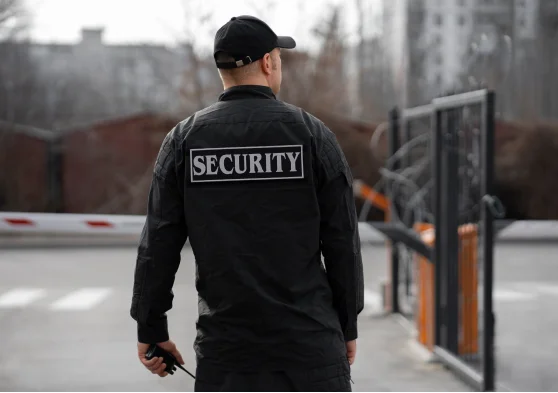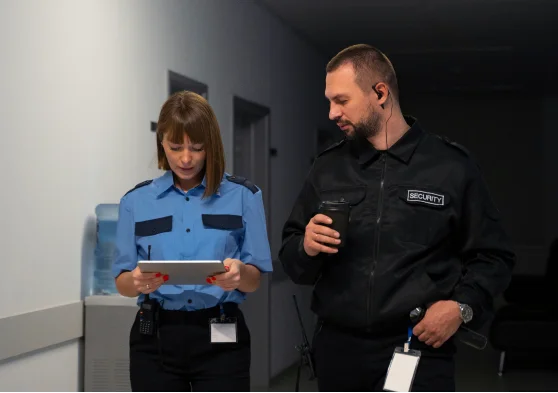Truck Stops, Transportation, and Logistics Security Guard Protocols in New York are vital to protect against theft, vandalism, and safety hazards, especially in areas where trucks, trailers, and cargo are stored or transported. These protocols ensure smooth operations and secure environments for truck drivers, freight companies, and logistics personnel.
Here’s a detailed guide of protocols a Safeguard Protected Security Guard follows for these facilities:
Truck Stops, Transportation, and Logistics Security Guard Protocols in NY
- Pre-Shift Protocols
- Equipment Check:
- Ensure that security equipment (e.g., radios, flashlights, mobile phones) is in working order.
- Verify surveillance equipment (CCTV cameras, license plate readers, etc.) is operational.
- Ensure fire extinguishers are easily accessible and operational.
- Briefing:
- Receive updates on any specific threats or concerns.
- Review daily logistics schedules, special deliveries, and known high-value cargo.
- Understand any potential access or security restrictions for certain areas.
- Equipment Check:
- Patrol and Access Control
- Vehicle and Pedestrian Access Control
- Monitor entrances and exits to ensure only authorized personnel or vehicles enter:
- Verify driver IDs, cargo manifests, and permits.
- Use automated gate systems or physical barriers to regulate traffic.
- Ensure truck drivers sign in and out and are properly documented.
- Monitor entrances and exits to ensure only authorized personnel or vehicles enter:
- ID Checks for Drivers and Visitors:
- Perform ID checks for all personnel (truck drivers, maintenance workers, delivery personnel) entering and exiting.
- Issue temporary access passes for authorized visitors.
- Vehicle Inspections
- Random vehicle inspections to check for stolen cargo, unauthorized materials, or security breaches.
- Ensure all truck doors and cargo areas are locked when vehicles are parked.
- Patrol Areas
- Regular foot and vehicle patrols across all high-traffic areas:
- Loading docks and storage yards
- Truck parking lots and trucker lounge areas
- Cargo storage areas
- Ensure secure fencing and gates are intact, free of damage.
- Regular foot and vehicle patrols across all high-traffic areas:
- Vehicle and Pedestrian Access Control
- Surveillance and Monitoring
- CCTV Monitoring
- Actively monitor CCTV cameras for suspicious activity, vehicle movements, or unauthorized access.
- Zoom in on high-risk areas, especially during nighttime hours or in remote sections of the yard.
- License Plate Recognition (LPR) Systems
- Ensure LPR systems are functioning and correctly logging the entry and exit of trucks.
- Cross-reference vehicle IDs with expected or authorized deliveries.
- CCTV Monitoring
- Incident Reporting and Emergency Protocols
- Suspicious Activity
- In case of suspicious activity or potential threats:
- Immediately report to local law enforcement and management.
- Maintain a safe distance from suspects and avoid confrontation.
- Document incidents in a security log and escalate if necessary.
- In case of suspicious activity or potential threats:
- Theft or Vandalism
- If a theft or vandalism incident occurs:
- Contact local authorities (NYPD) immediately.
- Secure the scene, and prevent unauthorized access until police arrive.
- Document the incident with detailed reports (e.g., damage, stolen goods, security footage).
- If a theft or vandalism incident occurs:
- Fire or Hazardous Material Response
- Fire or explosion threats must be immediately addressed by:
- Notifying local fire services (FDNY).
- Ensuring personnel are evacuated from danger zones.
- Deploying fire extinguishers or a fire hose if the situation is manageable until emergency services arrive.
- For hazardous material spills or accidents, alert hazmat teams immediately and prevent further exposure or contamination.
- Fire or explosion threats must be immediately addressed by:
- Suspicious Activity
- Security in High-Risk Areas
- Truck Parking and Rest Areas
- Ensure that truck parking areas are well-lit and secure, particularly during nighttime or when lots are full.
- Enforce rest period policies to ensure drivers rest in designated areas and are not disturbed by unauthorized individuals.
- Loading and Unloading Areas
- Monitor the loading docks to prevent unauthorized access and ensure that cargo is securely loaded/unloaded.
- Prevent tailgating at gates (unauthorized people following authorized vehicles).
- Trailer and Cargo Lock Security
- Regularly check that trailers are locked and secured while parked, particularly if left unattended.
- Monitor high-value loads or shipments closely, ensuring they are properly documented and tracked.
- Truck Parking and Rest Areas
- Emergency Preparedness
- Evacuation Plans
- Be aware of evacuation routes and muster points in case of emergency situations like fires, explosions, or large-scale threats.
- Guide employees and truck drivers to the designated evacuation area if needed.
- Medical Emergency Response
- If a medical emergency occurs:
- Call 911 and alert medical teams.
- If possible, provide first aid until paramedics arrive.
- Assist with crowd control and ensure a clear route for emergency services.
- If a medical emergency occurs:
- Evacuation Plans
- Post-Shift Protocols
- Shift Handover:
- Conduct a detailed shift change briefing to update the incoming guard on any incidents or security concerns.
- Ensure incident logs and security footage are handed over to management or the next shift.
- Documentation:
- Submit a detailed incident report for any notable events, suspicious activity, or accidents that occurred during the shift.
- Ensure security logs are updated with shift details, visitor activity, patrol routes, and any security issues.
- Shift Handover:
- Legal Compliance and Security Standards
- Adherence to OSHA Regulations:
- Security guards are trained in safety protocols, including fire safety and emergency evacuations, in compliance with OSHA standards.
- Comply with New York State Transportation Laws:
- Ensure that all security measures align with New York State transportation laws, especially concerning cargo theft, vehicle inspections, and commercial driver safety.
- Adherence to OSHA Regulations:

When Security Guards Are Especially Needed

- High-traffic logistics centers
- Truck stops near busy highways or urban areas
- Facilities storing high-value goods, electronics, or pharmaceuticals
- Areas with large freight or high-volume transportation operations
Why Truck Stops, Transportation & Logistics Security Guards Matter in NY
- Prevent Cargo Theft and Vandalism
- New York’s logistics and transportation industry handles high-value goods, making truck stops and logistics centers prime targets for cargo theft.
- Security guards help monitor parking areas, loading docks, and trailers to prevent theft or vandalism.
- Guarding high-value cargo like electronics, pharmaceuticals, and retail goods minimizes the risk of financial loss for trucking companies.
- Preventing vandalism ensures minimal damage to property and the preservation of goods.
- Traffic and Access Control
- Truck stops and logistics hubs can get congested, especially in high-traffic areas like NYC.
- Security guards play a key role in managing traffic flow, ensuring that only authorized trucks, vehicles, and personnel have access to restricted areas.
- Guards check IDs, permits, and cargo manifests.
- They prevent unauthorized parking, tailgating, and trespassing, ensuring only legitimate activity occurs at entry points.
- Fire Safety and Emergency Response
- With flammable materials and hot work activities occurring at many logistics sites, fire hazards are always a concern.
- Trained security guards are the first line of defense in detecting smoke, fire, or chemical hazards.
- They can activate emergency alarms, alert local fire departments, and help with evacuations if needed.
- Regular fire drills and hazard monitoring by guards keep the site compliant with local regulations.
- 24/7 Surveillance and Monitoring
- New York’s logistics operations run around the clock, and many facilities experience peak hours during nighttime, when the risk of theft and vandalism is higher.
- Security guards provide continuous surveillance through CCTV monitoring and physical patrols, keeping an eye on parking lots, loading docks, and storage areas.
- Live monitoring ensures that any suspicious activity is detected quickly, allowing for swift action before a situation escalates.
- Protection of Drivers and Employees
- Truck drivers and logistics staff face unique challenges, especially in urban environments like NYC, where safety and security may be compromised due to traffic congestion or unsavory activity.
- Security guards protect employees and truck drivers from assaults, robberies, or other criminal activity, providing a safe environment for workers to rest or wait.
- Guards at truck stops prevent potential violent incidents or disputes, which are common in high-traffic areas.
- Security Documentation and Incident Reporting
- Security guards maintain detailed logs of incidents, ensuring that any suspicious activity or security breaches are documented and reported.
- These logs can be vital for insurance claims, legal investigations, or regulatory compliance.
- Incident reports assist in tracking patterns of theft or other criminal activity, allowing management to implement better security measures in the future.
- Security guards maintain detailed logs of incidents, ensuring that any suspicious activity or security breaches are documented and reported.
- Reducing Risk in Urban Areas
- New York City and its surrounding boroughs are densely populated, and transportation facilities can be prime targets for criminal activity.
- Guards ensure that high-traffic hubs, such as those near port areas or rail yards, are secure against potential theft, terrorism, or vandalism.
- Guards can also act as a deterrent against illegal parking or unwanted trespassing.
- New York City and its surrounding boroughs are densely populated, and transportation facilities can be prime targets for criminal activity.
- Security for Supply Chain Operations
- Supply chain integrity is vital, and disruptions due to theft or security incidents can delay operations significantly.
- Having security guards at truck stops and logistics centers ensures that cargo is safely loaded, unloaded, and transported, keeping goods moving efficiently and securely.
- Security measures protect inventory and reduce delays, benefiting everyone from freight carriers to end customers.
- Liability Protection and Compliance
- Security guards help truck stops and logistics centers meet legal requirements and insurance mandates by maintaining secure environments.
- Compliance with OSHA, NYC Fire Code, and local transportation laws can be complex, but security guards ensure all regulations are followed.
- In the event of theft, accidents, or criminal activity, security personnel help reduce liability for the business by providing documentation, assisting in police investigations, and securing evidence.
- Security guards help truck stops and logistics centers meet legal requirements and insurance mandates by maintaining secure environments.
- Peace of Mind for Companies and Drivers
- Both logistics companies and truck drivers benefit from the peace of mind that comes with having professional security guards.
- Drivers can rest assured knowing their trucks and cargo are safe while they take breaks.
- Logistics companies can trust that their facilities are being monitored and protected, minimizing downtime and losses.
- Both logistics companies and truck drivers benefit from the peace of mind that comes with having professional security guards.

In Summary

Truck stops, transportation hubs, and logistics centers in New York are essential to the state’s economy but also face heightened risks. Security guards are critical in providing round-the-clock protection, managing traffic flow, preventing theft, and ensuring the safety of workers and drivers.
They not only safeguard physical assets but also improve operational efficiency and ensure that the logistics industry in NY continues to run smoothly.
